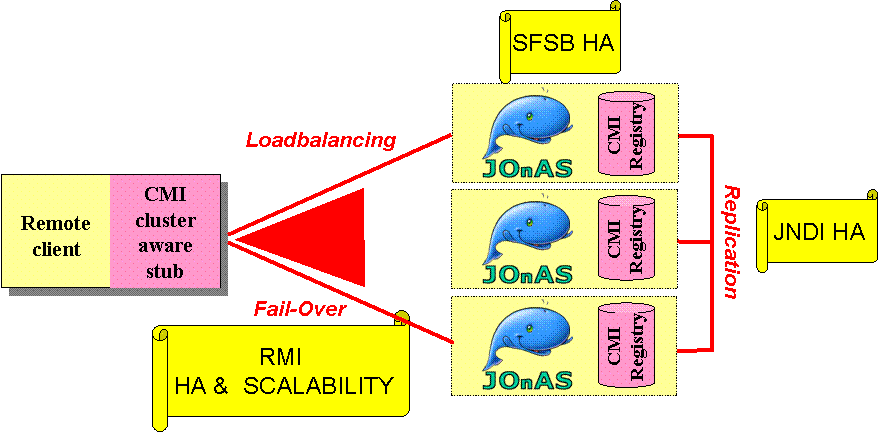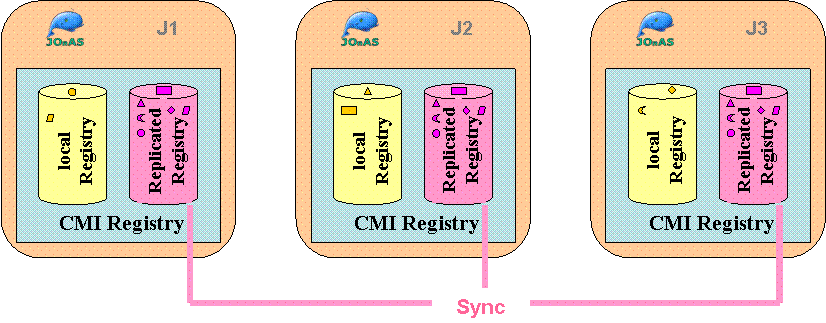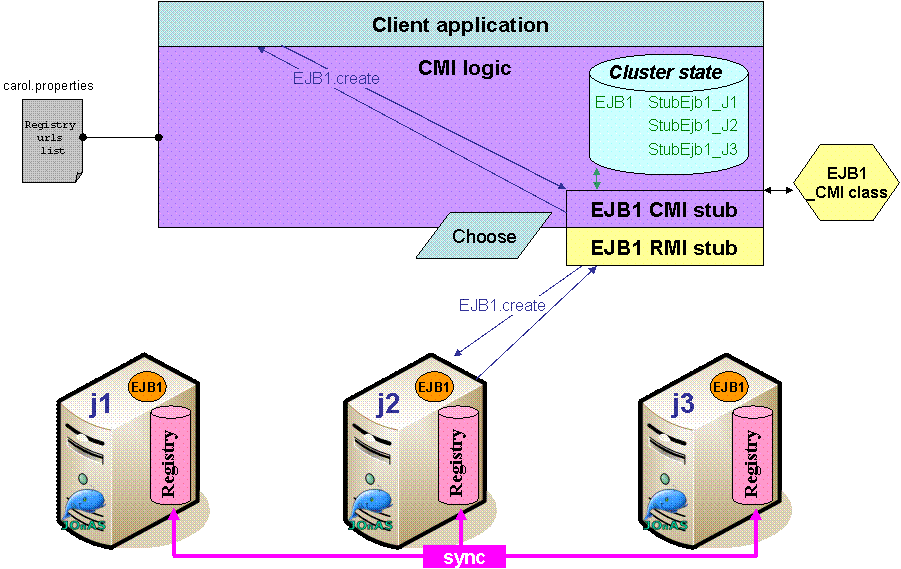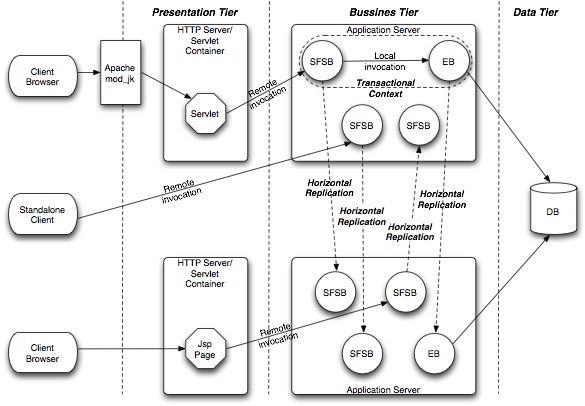
CMI is the protocol cluster for JOnAS ensuring:

CMI can be enabled in JOnAS by:
CMI brings its own registry for implementing the jndi replication. Each CMI registry instance over the cluster contains two areas:
When an object is registered in the registry, the routing to the local or global area is done according to:
The entries of the distributed area are lists providing the ability, for example, to gather several stubs for the the same jndi-name and thus to return a stubs list.
CMI relies on JGroups group-communication protocol for ensuring the global registry replication. The parameters are gathered in the:

All the members of a cluster share the same JGroups configuration.
If several cluster partitions are required over a single LAN, several JGroups configurations must be configured with different values for the following parameters:
When a new node appears in the cluster, its registry content is synchronized automatically.
When a node disappears, JGroups notifies the other's member of the node leaving and the registry entries related to this node are removed.
On the client side, the high availability of the registry is provided by the capability to set several JOnAS instances in the registry url. At the lookup time, the client chooses (round-robin algorithm) one of the available servers to get the home stub. If the server fails, the request is sent to another server. The CMI url registry is specified in the $JONAS_BASE/conf/carol.properties file using the following syntax:
carol.cmi.url=cmi://server1:port1[,server2:port2...]
Load-balancing and fail-over on the client side are provided through cluster-aware stubs. These stubs are generated on the fly through ASM and rely on:

The CMI cluster stub handles a cluster map on the client side. The CMI cluster stub is created:
In these two cases, the call gets a stubs list from the global registry and the CMI cluster stub updates the local cluster map. Afterwards, the local cluster map can be updated dynamically during the invocation of the business methods calls (through the HA interceptors) when a new view is detected in the cluster.
If a communication error with a server occurs during a remote call invocation, the server is removed from the cluster map.
CMI classes are generated by GenIC when compiling with the protocol CMI. They are built from the velocity templates located in $JONAS_ROOT/templates/genic directory. By default the templates used are:
The templates inherit the org.objectweb.carol.cmi.Distributor class and contain the following methods:
public StubData choose(Method method, Object[] parameters) throws NoServerException {
Set stubs = getCurrentState();
if (lastSet != stubs) {
lastSet = stubs;
rr.update(stubs);
}
return rr.get();
}
protected static boolean mustFailover(Exception ex) {
if (ex instanceof UnmarshalException) {
Throwable cause = ((UnmarshalException) ex).getCause();
if (( cause instanceof EOFException) ||
(cause instanceof SocketException)) {
return true;
}
}
if ((ex instanceof ConnectException) ||
(ex instanceof ConnectIOException) ||
(ex instanceof NoSuchObjectException)) {
return true;
}
return false;
}
The user has the ability to customize the load-balancing and fail-over logic for each EJB by specifying the velocity template to use in the JOnAS- specific descriptor on deployment of the ejb-jar file. The XML elements are:
<cluster-home-distributor>MyHomeDistributor.vm</cluster-home-distributor>
<cluster-remote-distributor>MyRemoteDistributor.vm</cluster-remote-distributor>
If not set, the default velocity templates are used.
If set with the value 'disabled', the CMI classes are not generated and the EJB will not be distributed.
If set with a file name, this file must be located in the $JONAS_ROOT/templates/genic directory.
The 'cluster-home-distributor' element is valid for the SSB, SFSB and EB.
The 'cluster-remote-distributor' element is valid for the SSB.
Stateful session beans (SFSBs) can be replicated since JOnAS 4.7 in order to provide high availability in the case of failures in clustered environments. A new service called High Availability (HA) has been included in JOnAS to provide replication mechanishms. JOnAS HA also requires the cluster method invocation (CMI) protocol.
Compared to JOnAS 4.7, JOnAS 4.8 implements a new replication algorithm based on a horizontal replication approach. The algorithm improves the algorithm implemented for JOnAS 4.7 with the following enhancements:
JOnAS implements an update-everywhere replication protocol according to the database replication terminology (See the J. Gray et al.'s paper ''The dangers of replication and a solution'' in proceedings of the ACM SIGMOD 96's conference, Canada). In this protocol, a client can connect to any server. When the client calls the create() method on the SFSB's Home interface, the server the client connects to is selected following a round-robin scheme. All the requests from the client to the SFSB will be processed by this server until the client calls the remove() method on the remote interface. The rest of the servers will act as backups for that client. Before sending the response to the client, the SFSB's state is sent to the backups.
If the server fails, another server among the backups will be selected to serve the client requests, first restoring the current state of the SFSBs from the state information stored in the HA local service. From this point on, this server will receive the new client requests.
The supported replication scenarios are shown in the following figure:

The horizontal approach aims to guarantee that the transactions are kept consistent when a fail-over occurs. They are either aborted or restored for ensuring the exactly-once semantics. During a fail-over, the new primary uses a special table in the database for storing the transaction identifier and enabling to find out if the transaction was committed or not.
The High Availability (HA) service is required in JOnAS in order to replicate SFSBs. The HA service must be included in the list of available services in JOnAS. This is done in the jonas.properties file placed in $JONAS_BASE/conf.
... jonas.services registry,jmx,jtm,db,dbm,security,resource,ejb,ws,web,ear,ha ...
The HA service must also be configured in the jonas.properties file:
... jonas.service.ha.class org.objectweb.jonas.ha.HaServiceImpl jonas.service.ha.gcl jgroups ...
The HA service uses JGroups as a group communication layer (GCL). JGroups behavior is specified by means of a stack of properties configured through an XML file (See JGroups documentation for more information: http://www.jgroups.org). The default configuration of the HA service uses the $JONAS_BASE/conf/jgroups-ha.xml file and the sfsb-rep group name. The HA service can be told to use a particular stack configuration or a particular group name by modifying the following lines in jonas.properties:
... jonas.service.ha.jgroups.conf jgroups-ha.xml jonas.service.ha.jgroups.groupname jonas-rep ...Finally, the CMI protocol must be specified in the carol.properties file in $JONAS_BASE/conf:
... carol.protocols=cmi... ...
The new horizontal replication algorithm uses a database table to keep track of current running transactions. This table is accessed from the new elected node during fail-over to detect whether or not the current transaction committed at the former local node, ensuring exactly-once semantics. The table contains only one column: the transaction identifier (txid).
In JOnAS 4.8 this table must be created manually with the following SQL command:
create TABLE ha_transactions (txid varchar(60));
This table should be located preferably in the database used by the replicated application, but it is not mandatory. If the table is not created in the database used by the replicated application, it is necessary to configure a new datasource for the database that contains this transaction table. This datasource must be configured to use the serializable transaction isolation level.
The database that holds the transaction table is accessed by the replication service with the JNDI name configured in jonas.properties.
... jonas.service.ha.datasource tx_table_ds ...
... jonas.service.ha.timeout 600 ...
In order to configure an application for replication, the <cluster-replicated/> element must be added to the bean definition of every bean requiring high availability in the jonas-ejb-jar.xml deployment descriptor file. This element can have two possible values: true or false (default value). In addition, if the programmer wants to change the behavior of the CMI stubs (e.g., the server selection policy), it is possible to specify different distributor implementations by means of <cluster-home-distributor/> and <cluster-remote-distributor/> elements. In this case, the value corresponds to the .vm file that implements the distributor in its home and remote parts respectively. If the <cluster-replicated/> element is present without the <cluster-*-distributor/> elements, the default values are used (ClusterHomeSFSBRepDistributor.vm and ClusterRemoteSFSBRepDistributor.vm).
The following is an example description for a replicated SFSB in jonas-ejb-jar.xml file:
... <jonas-session> <ejb-name>DummySFSB</ejb-name> <jndi-name>DummySFSB</jndi-name> ... <cluster-replicated>true</cluster-replicated> <cluster-home-distributor>Dummy_HomeDistributor.vm</cluster-home-distributor> <cluster-remote-distributor>Dummy_RemoteDistributor.vm</cluster-remote-distributor> </jonas-session> ...
The <cluster-replicated/> element can also be set in the SSB or EB for
Note: When set in the SSB, the mechanism inhibits the load-balancing at the remote interface. After the home create() method call, all the requests are sent to the same instance.
The lock policy for the Entity Beans in a replicated application must be configured as database in the jonas-ejb-jar.xml deployment descriptor file.
The following is an example description for a replicated EB in the jonas-ejb-jar.xml:
...
<jonas-entity>
<ejb-name>MyEntitySLR</ejb-name>
<jndi-name>MyEntityHome</jndi-name>
<cluster-replicated>true</cluster-replicated>
<shared>true</shared>
<jdbc-mapping>
<jndi-name>example_ds</jndi-name>
</jdbc-mapping>
<lock-policy>database</lock-policy>
</jonas-entity>
...
The datasources used by replicated applications must be configured to use the serializable transaction isolation level.
The following is an example for a datasource configuration file for the Postgres DBMS:
... datasource.name example_ds datasource.url jdbc:postgresql://xxx.xxx.xxx.xxx:xxxx/database datasource.classname org.postgresql.Driver datasource.username jonas datasource.password datasource.mapper rdb.postgres datasource.isolationlevel serializable ...
Finally, when compiling the application that includes the replicated beans, the CMI protocol must be specified in order to generate the classes that include the replication logic.
NOTE: It is recomended to not change the Datasource once the HA service is running.